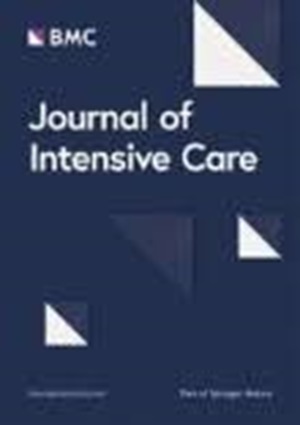Hospital and regional variations in intensive care unit admission for patients with invasive mechanical ventilation
IF 4.7
2区 医学
Q1 CRITICAL CARE MEDICINE
引用次数: 0
Abstract
Patients who receive invasive mechanical ventilation (IMV) in the intensive care unit (ICU) have exhibited lower in-hospital mortality rates than those who are treated outside. However, the patient-, hospital-, and regional factors influencing the ICU admission of patients with IMV have not been quantitatively examined. This retrospective cohort study used data from the nationwide Japanese inpatient administrative database and medical facility statistics. We included patients aged ≥ 15 years who underwent IMV between April 2018 and March 2019. The primary outcome was ICU admission on the day of IMV initiation. Multilevel logistic regression analyses incorporating patient-, hospital-, or regional-level variables were used to assess cluster effects by calculating the intraclass correlation coefficient (ICC), median odds ratio (MOR), and proportional change in variance (PCV). Among 83,346 eligible patients from 546 hospitals across 140 areas, 40.4% were treated in ICUs on their IMV start day. ICU admission rates varied widely between hospitals (median 0.7%, interquartile range 0–44.5%) and regions (median 28.7%, interquartile range 0.9–46.2%). Multilevel analyses revealed significant effects of hospital cluster (ICC 82.2% and MOR 41.4) and regional cluster (ICC 67.3% and MOR 12.0). Including patient-level variables did not change these ICCs and MORs, with a PCV of 2.3% and − 1.0%, respectively. Further adjustment for hospital- and regional-level variables decreased the ICC and MOR, with a PCV of 95.2% and 85.6%, respectively. Among the hospital- and regional-level variables, hospitals with ICU beds and regions with ICU beds had a statistically significant and strong association with ICU admission. Our results revealed that primarily hospital and regional factors, rather than patient-related ones, opposed ICU admissions for patients with IMV. This has important implications for healthcare policymakers planning interventions for optimal ICU resource allocation.有创机械通气患者入住重症监护病房的医院和地区差异
在重症监护室(ICU)接受有创机械通气(IMV)的患者的院内死亡率低于在室外接受治疗的患者。然而,患者、医院和地区因素对有创机械通气患者入住重症监护室的影响尚未得到量化研究。这项回顾性队列研究使用的数据来自日本全国住院病人管理数据库和医疗机构统计数据。我们纳入了2018年4月至2019年3月期间接受IMV的年龄≥15岁的患者。主要结果是在开始 IMV 的当天入住 ICU。通过计算类内相关系数(ICC)、中位数比值比(MOR)和方差比例变化(PCV),采用包含患者、医院或地区级变量的多层次逻辑回归分析来评估群集效应。在来自 140 个地区 546 家医院的 83346 名符合条件的患者中,40.4% 的患者在 IMV 开始日在 ICU 接受治疗。不同医院(中位数为 0.7%,四分位距为 0-44.5%)和不同地区(中位数为 28.7%,四分位距为 0.9-46.2%)的 ICU 入院率差异很大。多层次分析显示,医院群(ICC 82.2%,MOR 41.4)和地区群(ICC 67.3%,MOR 12.0)具有显著影响。纳入患者水平变量并未改变这些 ICC 和 MOR,PCV 分别为 2.3% 和 -1.0%。进一步调整医院和地区水平变量后,ICC 和 MOR 均有所下降,PCV 分别为 95.2% 和 85.6%。在医院和地区变量中,拥有重症监护病房床位的医院和拥有重症监护病房床位的地区与入住重症监护病房有显著的统计学关联。我们的研究结果表明,影响 IMV 患者入住 ICU 的主要是医院和地区因素,而不是与患者相关的因素。这对医疗决策者规划干预措施以优化 ICU 资源分配具有重要意义。
本文章由计算机程序翻译,如有差异,请以英文原文为准。
求助全文
约1分钟内获得全文
求助全文
来源期刊

Journal of Intensive Care
Medicine-Critical Care and Intensive Care Medicine
CiteScore
11.90
自引率
1.40%
发文量
51
审稿时长
15 weeks
期刊介绍:
"Journal of Intensive Care" is an open access journal dedicated to the comprehensive coverage of intensive care medicine, providing a platform for the latest research and clinical insights in this critical field. The journal covers a wide range of topics, including intensive and critical care, trauma and surgical intensive care, pediatric intensive care, acute and emergency medicine, perioperative medicine, resuscitation, infection control, and organ dysfunction.
Recognizing the importance of cultural diversity in healthcare practices, "Journal of Intensive Care" also encourages submissions that explore and discuss the cultural aspects of intensive care, aiming to promote a more inclusive and culturally sensitive approach to patient care. By fostering a global exchange of knowledge and expertise, the journal contributes to the continuous improvement of intensive care practices worldwide.
 求助内容:
求助内容: 应助结果提醒方式:
应助结果提醒方式:


